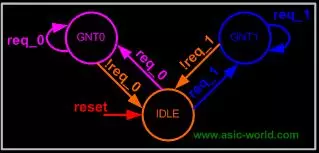Introduction
每个Verilog初学者的梦想是在一天内理解它,至少到达足够使用的程度。接下来的Verilog Basics的几篇文章将会让这个梦想成为现实。
尽管Verilog是并行地执行不同的代码块,但它和大多数顺序执行的编程语言仍有许多相似之处。我们需要的只是一些数字电路的基础。
在Verilog出现之前,电路设计者使用原理图进行电路设计。无论复杂程度如何,每个设计都是通过原理图设计的。这使得设计难以验证并且容易出错,导致**设计...验证,设计...验证,设计...验证,设计...验证。。。繁琐的迭代。
当Verilog出现时,我们对数字电路设计有了不同的思维方式。使用Verilog进行数字电路的功能设计周期类似于传统的程序开发周期。
- Specifications (specs)
- High level design
- Low level (micro) design
- RTL coding
- Verification
- Synthesis.
首先我们需要一个specifications,列出我们对设计的限制(restrictions )和要求(requirements)
本教程,我们将设计一个仲裁器(arbiter),以下是仲裁器的一些规范。
两个agent
异步复位,高有效
固定优先级,agent0优先于agent1
在我们有了规范之后,我们就可以绘制框图,即设计数据流的黑匣子。
Block diagram of arbiter
如果没有Verilog,下一步我们需要开始绘制状态机。我们制作一个具有状态转换的真值表,然后绘制卡诺图并化简优化电路。
每个圆圈表示状态可能处于的状态。每个状态都有相对应的输出。状态之间的箭头是不同事件导致的状态转换。
例如,最左边的橙色箭头表示如果机器处于GNT0状态(输出对应于GNT0的信号)并接收到!req\_0的输入,则状态机移动到状态IDLE并输出与之对应的信号。
这种设计方法适用于小型设计,但对于大型设计,这种流程变得复杂且容易出错。这就是Verilog的用武之地。
Modules
在仲裁块的框图中,我们可以看到它有一个名字(“arbiter”)和输入/输出端口(req\_0,req\_1,gnt\_0和gnt\_1)。
在Verilog中,我们使用module 来描述这个具有相同输入和输出的黑匣子。
此代码如下所示。
module arbiter (
// Two slashes make a comment line.
clock , // clock
reset , // Active high, syn reset
req_0 , // Request 0
req_1 , // Request 1
gnt_0 , // Grant 0
gnt_1 // Grant 1
);
//-------------Input Ports-----------------------------
// Note : all commands are semicolon-delimited
input clock ;
input reset ;
input req_0 ;
input req_1 ;
//-------------Output Ports----------------------------
output gnt_0 ;
output gnt_1 ;
Data Type
在硬件中存在两种数据类型
- 可以存储值的数据类型(例如:flip-flop)。
- 无法存储值的数据类型,但可以连接两个点(例如:wire)。
第一种类型在Verilog中称为reg(“register”的缩写)。第二种数据类型称为导线(“wire”)。
例如:
wire and_gate_output;
reg d_flip_flop_output;
reg [7:0] address_bus;
Operators
Verilog中的运算符与其他编程语言几乎相同。
| perator Type | Operator Symbol | Operation Performed | ||
|---|---|---|---|---|
| Arithmetic | * | Multiply | ||
| / | Division | |||
| + | Add | |||
| - | Subtract | |||
| % | Modulus | |||
| + | Unary plus | |||
| - | Unary minus | |||
| Logical | ! | Logical negation | ||
| && | Logical and | |||
| \ | \ | Logical or | ||
| Relational | > | Greater than | ||
| < | Less than | |||
| \>= | Greater than or equal | |||
| <= | Less than or equal | |||
| Equality | == | Equality | ||
| != | inequality | |||
| Reduction | \~ | Bitwise negation | ||
| \~& | nand | |||
| \ | or | |||
| \~\ | nor | |||
| ^ | xor | |||
| ^\~ | xnor | |||
| \~^ | xnor | |||
| Shift | \>\> | Right shift | ||
| << | Left shift | |||
| Concatenation | { } | Concatenation | ||
| Conditional | ? | conditional |
例如:
a = b + c;
a = 1 << 5;
a =!b;
a = ~b;
本文转载自公众号:芯片数字实验室
原文链接:https://mp.weixin.qq.com/s/zaWsH06DLQWqqCoYSRoQLw
未经作者同意,请勿转载!
推荐阅读:
想了解更多内容,欢迎关注芯片数字实验室专栏




